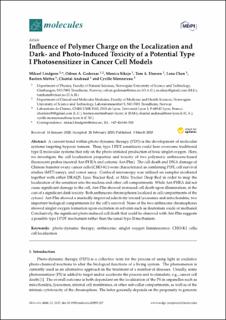| dc.contributor.author | Lindgren, Mikael | |
| dc.contributor.author | Gederaas, Odrun Arna | |
| dc.contributor.author | Siksjø, Monica | |
| dc.contributor.author | Hansen, Tom Andre | |
| dc.contributor.author | Chen, Lena | |
| dc.contributor.author | Mettra, Bastien | |
| dc.contributor.author | Andraud, Chantal | |
| dc.contributor.author | Monnereau, Cyrille | |
| dc.date.accessioned | 2020-07-09T08:40:32Z | |
| dc.date.available | 2020-07-09T08:40:32Z | |
| dc.date.created | 2020-03-03T22:52:29Z | |
| dc.date.issued | 2020 | |
| dc.identifier.citation | Molecules. 2020, 25 (5), | en_US |
| dc.identifier.issn | 1420-3049 | |
| dc.identifier.uri | https://hdl.handle.net/11250/2661557 | |
| dc.description.abstract | A current trend within photo-dynamic therapy (PDT) is the development of molecular systems targeting hypoxic tumors. Thus, type I PDT sensitizers could here overcome traditional type II molecular systems that rely on the photo-initiated production of toxic singlet oxygen. Here, we investigate the cell localization properties and toxicity of two polymeric anthracene-based fluorescent probes (neutral Ant-PHEA and cationic Ant-PIm). The cell death and DNA damage of Chinese hamster ovary cancer cells (CHO-K1) were characterized as combining PDT, cell survival studies (MTT-assay), and comet assay. Confocal microscopy was utilized on samples incubated together with either DRAQ5, Lyso Tracker Red, or Mito Tracker Deep Red in order to map the localization of the sensitizer into the nucleus and other cell compartments. While Ant-PHEA did not cause significant damage to the cell, Ant-PIm showed increased cell death upon illumination, at the cost of a significant dark toxicity. Both anthracene chromophores localized in cell compartments of the cytosol. Ant-PIm showed a markedly improved selectivity toward lysosomes and mitochondria, two important biological compartments for the cell’s survival. None of the two anthracene chromophores showed singlet oxygen formation upon excitation in solvents such as deuterium oxide or methanol. Conclusively, the significant photo-induced cell death that could be observed with Ant-PIm suggests a possible type I PDT mechanism rather than the usual type II mechanism. | en_US |
| dc.language.iso | eng | en_US |
| dc.publisher | MDPI | en_US |
| dc.rights | Navngivelse 4.0 Internasjonal | * |
| dc.rights.uri | http://creativecommons.org/licenses/by/4.0/deed.no | * |
| dc.title | Influence of Polymer Charge on the Localization and Dark- and Photo-Induced Toxicity of a Potential Type I Photosensitizer in Cancer Cell Models | en_US |
| dc.type | Peer reviewed | en_US |
| dc.type | Journal article | en_US |
| dc.description.version | publishedVersion | en_US |
| dc.source.volume | 25 | en_US |
| dc.source.journal | Molecules | en_US |
| dc.source.issue | 5 | en_US |
| dc.identifier.doi | 10.3390/molecules25051127 | |
| dc.identifier.cristin | 1799462 | |
| dc.description.localcode | This is an open access article distributed under the Creative Commons Attribution License which permits unrestricted use, distribution, and reproduction in any medium, provided the original work is properly cited | en_US |
| cristin.ispublished | true | |
| cristin.fulltext | original | |
| cristin.qualitycode | 1 | |

